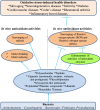A review on bacteria-derived antioxidant metabolites: their production, purification, characterization, potential applications, and limitations
- PMID: 40208553
- PMCID: PMC12058845
- DOI: 10.1007/s12272-025-01541-5
A review on bacteria-derived antioxidant metabolites: their production, purification, characterization, potential applications, and limitations
Abstract
Antioxidants are organic molecules that scavenge reactive oxygen species (ROS) and reactive nitrogen species (RNS), thereby maintaining cellular redox balance in living organisms. The human body synthesizes endogenous antioxidants, whereas humans obtain exogenous antioxidants from other organisms such as plants, animals, fungi, and bacteria. This review primarily focuses on the antioxidant potential of natural metabolites and extracts from five major bacterial phyla, including the well-studied Actinobacteria and Cyanobacteria, as well as less-studied Bacteroides, Firmicutes, and Proteobacteria. The literature survey revealed that the metabolites and the extracts with antioxidant activity can be obtained from bacterial cells and their culture supernatants. The metabolites with antioxidant activity include pigments, phycobiliproteins, polysaccharides, mycosporins-like amino acids, peptides, phenolic compounds, and alkaloids. Both metabolites and extracts demonstrate in vitro antioxidant capacity through radical-scavenging, metal-reducing, and metal-chelating activity assays. In in vivo models, they can scavenge ROS and RNS directly and/or indirectly eliminate them by enhancing the activities of antioxidant enzymes, such as catalase, superoxide dismutase, and glutathione peroxidase. Due to their antioxidant activities, they may find applications in the cosmetic industry as anti-aging agents for the skin and in medicine as drugs or supplements for combating oxidative stress-related disorders, such as neurodegenerative diseases and diabetes. The literature survey also elucidated that some metabolites and extracts with antioxidant activity also exhibited strong antimicrobial properties. Therefore, we consider that they may have future applications in the treatment of infectious diseases, the preparation of pathogen-free healthy foods, and the extension of food shelf life.
Keywords: Actinobacteria; Cyanobacteria; Proteobacteria; Exogenous antioxidants; Natural metabolites; Oxidative stress.
© 2025. The Author(s).
Conflict of interest statement
Declarations. Conflict of interest: The authors have declared no conflict of interest.
Figures




References
-
- Abd Ellatif SA, Bouqellah NA, Abu-Serie MM, Razik ESA, Al-Surhanee AA, Askary AE, Daigham GE, Mahfouz AY (2022) Assessment of probiotic efficacy and anticancer activities of Lactiplantibacillus plantarum ESSG1 (MZ683194.1) and Lactiplantibacillus pentosus ESSG2 (MZ683195.1) isolated from dairy products. Environ Sci Pollut Res Int 29(26):39684–39701. 10.1007/s11356-022-18537-z - PubMed
-
- Abdelaziz R, Tartor YH, Barakat AB, El-Didamony G, Gado MM, Zaki MSA, Eid RA, El-Samadony HA (2024) Alpha-sitosterol: a new antiviral agent produced by Streptomyces misakiensis and its potential activity against Newcastle disease virus. BMC Vet Res 20(1):76. 10.1186/s12917-023-03875-y - PMC - PubMed
-
- Ahmed IA, Mikail MA, Zamakshshari N, Abdullah ASH (2020) Natural anti-aging skincare: role and potential. Biogerontology 21:293–310. 10.1007/s10522-020-09865-z - PubMed
Publication types
MeSH terms
Substances
LinkOut - more resources
Full Text Sources
Medical

